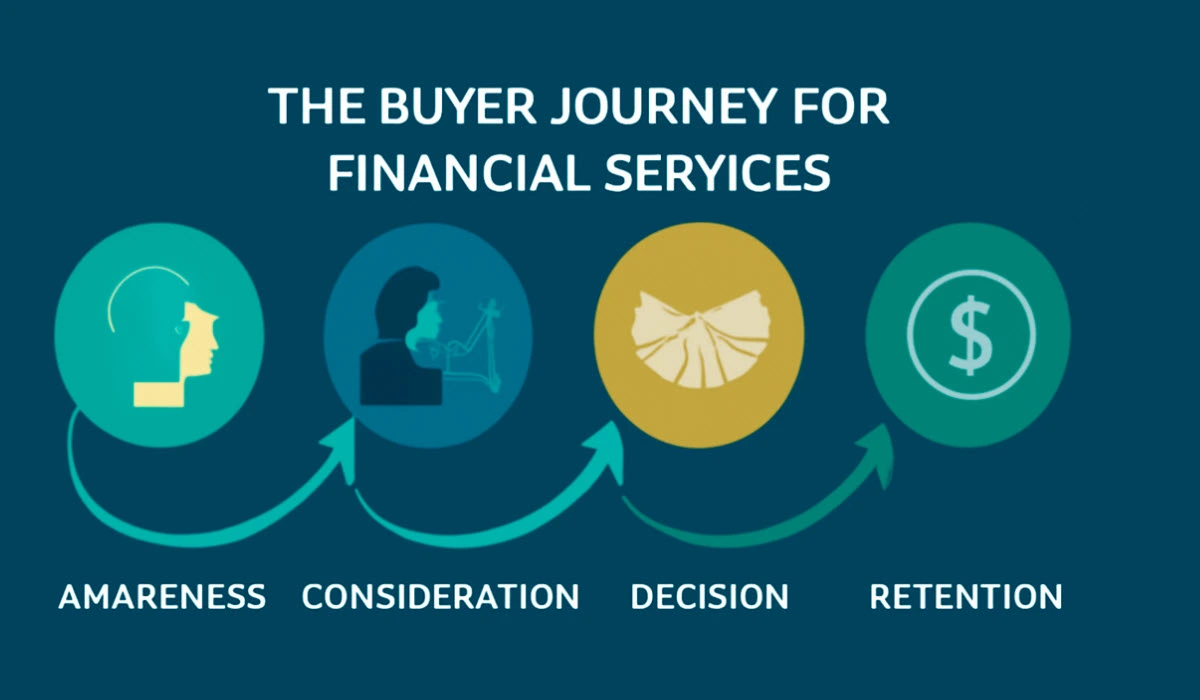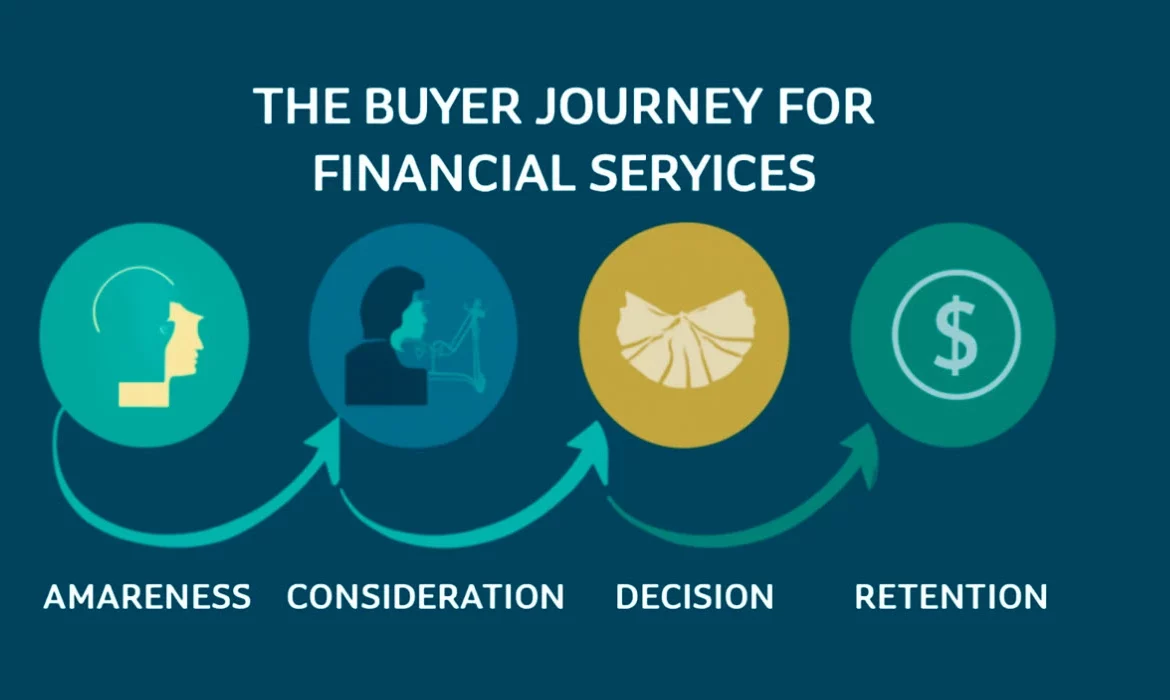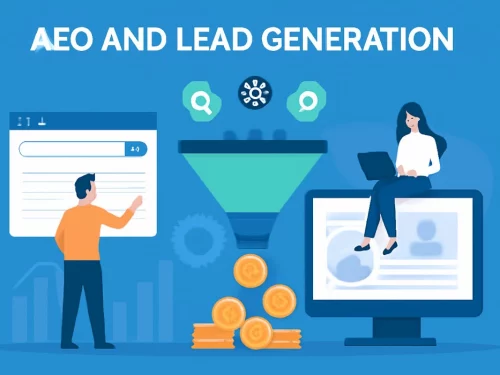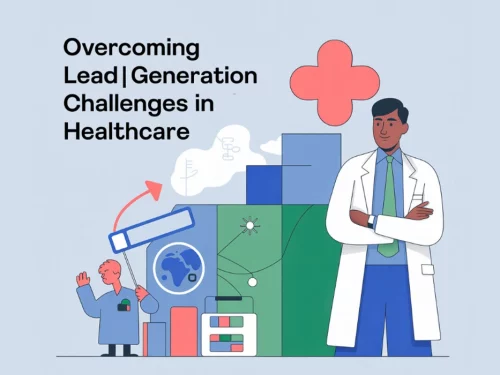
Let’s be honest; generating leads in the financial space is tough. Your targets are high-intent, high-stakes decision-makers: CFOs, wealth managers, and institutional investors.
They compare. They question. And if your message doesn’t meet them where they are, they disappear. Most financial firms skip one critical step: aligning their lead generation strategy with the actual buyer journey.
This blog fixes that. We’ll show you how to map your lead gen to real financial buyer behavior, solve common lead generation problems, and build strategies that bring in leads who are ready to move.
What Is the Financial Buyer’s Journey?
Before you generate a lead, you need to understand the path they walk. The buyer journey is the process every potential client takes from not knowing you exist to signing on the dotted line.
In finance, this journey is not fast or linear. It is cautious, considered, and layered. It typically unfolds in three phases:
1. Awareness
The client realizes they have a problem, such as poor portfolio performance or inefficient compliance workflows. However, they are not yet clear on what the solution is.
2. Consideration
The client begins exploring options. They compare providers and ask, “Can this firm solve my problem?”
3. Decision
The client is nearing the final decision. Now, it’s about trust, track record, and who best addresses their specific needs.
Why Is the Buyer Journey an Important Factor?
Understanding this process is where your financial services marketing should start to evolve. If you don’t know how your buyers think, you cannot build strategies that meet them at the right time with the right message.
This is where tools like a buyer persona for finance come in. You are not just targeting “leads” but specific roles with specific pain points.
The financial advisor guiding high-net-worth individuals. The fintech CTO solving integration issues. The bank executive navigating regulatory complexities.
Their journeys are different. But your job is the same: tailor your lead generation strategy to fit how they buy, not how you sell.
5 Major Lead Generation Problems in the Finance Sector
Lead generation in finance isn’t as simple as pushing ads or posting content. The real issue? Most financial companies are solving the wrong problems. They chase more traffic, but ignore targeted lead generation. Here are the core issues:
1. Unqualified Leads
Attracting leads who aren’t the right fit. It’s tempting to focus on volume, but without buyer persona, you risk generating traffic that doesn’t convert.
2. Poor Targeting
If your targeting doesn’t align with the stages of the buyer journey, you’re wasting budget. Generic campaigns often fail to resonate with high-value clients who need a tailored approach.
3. Ineffective Follow-Up
Leads express interest, but then disappear. Without automated, personalized nurturing, they slip through the cracks. It’s essential to follow up in a way that aligns with their position in the journey.
4. Misaligned Content
Content that’s too broad or off-point won’t engage potential clients. Providing generic education doesn’t speak to a CFO or a wealth manager at the decision stage. You need targeted, insightful content that addresses their specific concerns.
5. Lack of Trust Signals
Financial buyers need proof before they commit. Without testimonials, case studies, or visible credibility markers, your leads might hesitate to make the final move. Building trust is crucial, especially in the finance sector.
Now that you understand the financial buyer’s journey and the common lead generation problems, it’s time to implement actionable strategies that really move the needle.
7 Lead Generation Best Practices for Financial Services
Now that you understand the financial buyer’s journey and the common lead generation problems, it’s time to implement actionable strategies that really move the needle.
1. Develop and Use Detailed Buyer Personas for Finance
In financial services, one-size-fits-all messaging simply doesn’t work. To attract qualified leads, create detailed buyer personas for finance.
These personas should reflect real-world roles like wealth managers, CFOs, or institutional investors. Understand their pain points, needs, and decision-making criteria at each stage of the buyer journey.
The more detailed your persona, the more specific and compelling your content becomes.
2. Target Long-Tail Keywords Specific to Financial Buyers
Generic keywords like “investment management” won’t do the job. Targeted lead generation requires focusing on long-tail keywords that reflect what your ideal client is actively searching for.
For example, terms like “compliance software for fintech companies” or “tax planning tools for high-net-worth individuals” target more specific search intent, which is key to attracting the right type of buyer.
3. Customize Content for Every Stage of the Buyer’s Journey
Content marketing in financial services must align with where the buyer is in their journey.
- Top of the Funnel (TOFU): Awareness content like blogs, guides, and infographics.
- Middle of the Funnel (MOFU): Case studies, webinars, and detailed solution comparisons.
- Bottom of the Funnel (BOFU): Product demos, consultations, and ROI calculators.
Content should move buyers seamlessly through the funnel, addressing their concerns at each stage, and ultimately guiding them toward making a purchase decision.
4. Personalize Outreach with Automated Nurturing
Financial buyers are busy. The key is to stay top of mind without overwhelming them. Use email automation to encourage leads with personalized, value-driven content that speaks to their specific needs.
Tailor messaging based on their stage in the buyer journey, whether that’s offering helpful educational content or sending an invitation to a demo.
5. Leverage Trust Signals to Build Credibility
For financial advisor marketing, credibility is crucial. Add client testimonials, industry certifications, and case studies to your site.
Consider featuring third-party endorsements like awards or positive press mentions. Trust is a huge factor in the financial sector, and without it, your leads may never convert.
6. Optimize Landing Pages for High-Converting Content
Don’t send your leads to generic landing pages. Create custom landing pages for specific financial services, complete with targeted messaging, personalized CTAs, and content that speaks straight to the buyer’s pain points.
Make sure the page is easy to navigate, fast to load, and mobile-friendly to maximize your conversion rates.
7. Invest in Paid Search and Retargeting Campaigns
SEO is vital, but don’t forget about the immediate results that paid ads and retargeting can bring.
- Paid Search: Target high-intent search terms to attract leads who are already looking for solutions.
- Retargeting: Stay in front of potential clients who have already interacted with your content, nurturing them until they’re ready to convert.
How Targeted Lead Generation Doubled Qualified Leads for a Finance Brand
To truly understand how refining your lead generation strategy can dramatically impact results, let’s look at an inspirational case study of a leading wealth management firm that faced similar challenges and transformed its approach.
The Challenges:
A mid-sized wealth management firm faced a key issue: despite decent website traffic, their lead conversion rates were low. They were running multiple ad campaigns, creating educational content, and sending targeted emails, but the leads simply weren’t converting.
The firm was struggling with:
- Unqualified leads due to broad, undifferentiated targeting.
- Misaligned content that didn’t address the unique needs of high-net-worth individuals (HNIs).
- A lack of trust signals, which made prospects hesitant to move forward.
The Strategy:
To solve this, the firm partnered with an SEO and content marketing agency that understood financial buyer behavior and the importance of the buyer journey. They began by segmenting their audience into clear personas: wealth managers, investors, and family offices.
The team then tailored each aspect of the strategy to these personas at each stage of the journey. Key steps included:
- Mapping the Buyer Journey: Aligning their content to meet prospects at the right stage: top-of-funnel educational pieces, middle-of-funnel case studies, and bottom-of-funnel decision-making content.
- Targeted Lead Generation: Focusing on more specific keywords and content that spoke directly to each persona’s pain points. They started using long-tail keywords like “wealth management services for family offices” and “investment portfolio strategies for high-net-worth individuals.”
- Nurturing Through Automation: Setting up an automated email sequence to stay in touch with leads, offering relevant resources based on their engagement, and keeping them progressing through the funnel.
- Trust Signals: Adding client testimonials, case studies, and industry certifications to increase credibility and trust elements that financial buyers demand before making decisions.
The Results:
- Qualified leads doubled within 3 months of implementing the new strategy.
- Engagement rates soared as content became more tailored and relevant.
- Conversion rates increased by 47% as the right leads were nurtured at the right time.
How Can You Align Your Lead Generation Strategy?
Attracting qualified leads isn’t just about generating traffic; it’s about understanding where your prospects are in their decision-making journey and meeting them with the right message at the right time.
If you don’t align your lead generation strategy with the stages of the buyer journey, you risk being invisible when your prospects are ready to make a decision.
Stage 1: Awareness – Capture Attention Early
At the awareness stage, potential clients recognize a problem but haven’t yet decided on a solution. Your goal here is to introduce your brand as a trusted resource.
Best Practices:
- Educational Content: Use blog posts, videos, and infographics that highlight pain points, common problems, and potential solutions. Focus on building awareness around the problem your solution addresses rather than jumping into selling.
- SEO for Discoverability: At this stage, content optimized for search intent such as “how-to” guides and educational articles is crucial for attracting those just beginning to look for solutions.
Stage 2: Consideration – Engage with Value
Once prospects are aware of their problem, they begin researching options. This is where you need to engage them with valuable content that positions your offering as a viable solution.
Best Practices:
- Personalized Content: Share more in-depth resources such as case studies, whitepapers, and solution comparisons. Tailor these materials to your buyer persona for finance, addressing their unique concerns.
- Targeted Lead Generation: Focus on long-tail keywords and more specific topics that align with the pain points of your ideal buyers. For example, instead of just “wealth management,” use phrases like “wealth management strategies for family offices.”
- Email Nurturing: Use targeted emails to nurture leads, offering relevant content based on their engagement so far. Automated email sequences can be an excellent way to keep prospects engaged.
Stage 3: Decision – Drive Conversion with Trust
At the decision stage, prospects are evaluating solutions and vendors. Your role here is to build trust and help them make the final call.
Best Practices:
- Case Studies & Testimonials: Include detailed success stories, client testimonials, and any relevant case studies that show how your solution works in the real world.
- Clear Call to Action (CTA): Make it easy for prospects to take the next step whether it’s scheduling a demo, signing up for a consultation, or getting a free trial. Your CTA should be direct, clear, and aligned with their decision-making process.
- Trust Signals: Incorporate badges, certifications, and guarantees that reinforce your credibility. Financial buyers need assurance that they are making the right decision.
EvenDigit – Map Smarter. Market Smarter. Convert Better.
Understanding the financial buyer journey is one thing. Turning that understanding into a lead generation strategy that consistently delivers qualified leads is where the real impact happens.
With over 15+ years of experience, we have fine-tuned our approach for fintech companies and financial services firms, blending industry knowledge with proven strategies to accelerate your growth.
Our team doesn’t just optimize for rankings or clicks. We optimize for conversions at every stage of the buyer journey. From creating the right content for the right audience to ensuring your technical setup is spot on, we cover all the bases.
Ready to go from just attracting traffic to generating high-quality leads? At EvenDigit, we help you transform your SEO efforts into a growth engine.
Let’s discuss your tailored lead-generation strategy today!
EvenDigit
EvenDigit is an award-winning Digital Marketing agency, a brand owned by Softude (formerly Systematix Infotech) – A CMMI Level 5 Company. Softude creates leading-edge digital transformation solutions to help domain-leading businesses and innovative startups deliver to excel.
We are a team of 70+ enthusiastic millennials who are experienced, result-driven, and hard-wired digital marketers, and that collectively makes us EvenDigit. Read More




